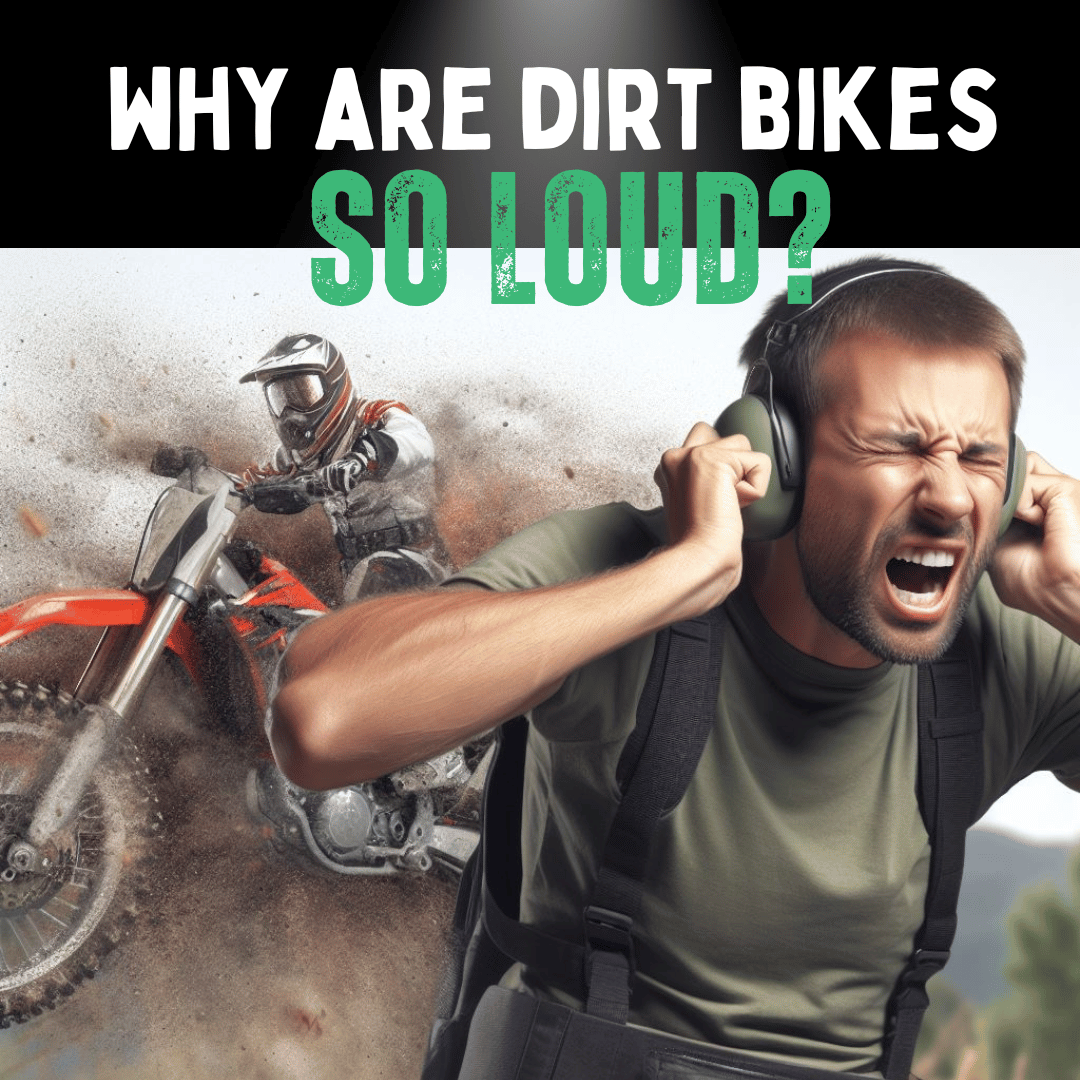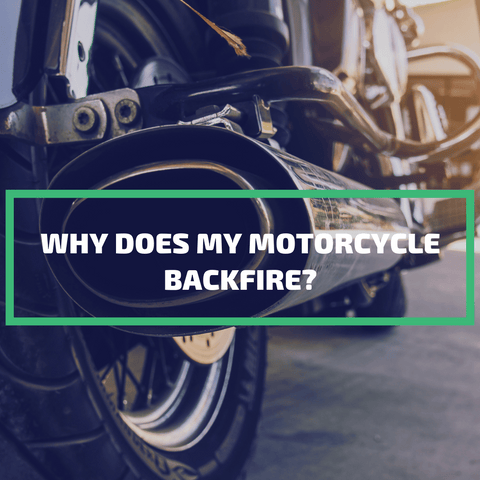Published: 04.10.23
Updated: 27.05.25
While strolling through the woods or along a trail, the sudden roar of a dirt bike often breaks the silence, grabbing your attention.
For those unfamiliar, you might wonder: why are dirt bikes so loud?
Join us for an exciting journey into the world of dirt bikes as we explore the reasons behind their distinctive noise, from engine types to rider preferences.
Why Are Dirt Bikes So Loud?
Dirt bikes are loud due to two-stroke or four-stroke engines, compact mufflers, high RPMs, and frequent acceleration. Riders may modify exhausts for performance or safety, amplifying noise for brand identity or preference.
| Reason | Description |
|---|---|
| Two-Stroke Engines | Simpler cycles produce frequent, loud exhaust pulses. |
| Four-Stroke Engines | Quieter but still noisy when modified or used for racing. |
| Compact Mufflers | Shorter mufflers enhance agility but reduce noise suppression. |
| High RPMs | Higher revolutions per minute increase sound levels. |
| Frequent Acceleration | Dynamic acceleration creates the iconic "braaap" sound. |
1. Engine Types and Performance
Two-Stroke vs. Four-Stroke Engines
Dirt bikes use either two-stroke or four-stroke engines, each contributing to noise levels differently. Two-stroke engines, with their simpler cycle, produce frequent and louder exhaust pulses, making them noisier. Four-stroke engines are generally quieter but can still be loud when modified for racing or performance. Both are optimised for power, much like sports cars in the off-road world.
Explore our range of kids’ petrol ride-on motorbikes for a quieter, family-friendly alternative.
Related: Motorcycle Backfire: 12 Common Causes Explained
High RPMs
Dirt bikes operate at high RPMs, akin to a racing heartbeat. This high-revving nature, essential for off-road performance, naturally increases noise levels.
Related: How to Measure RPM on Your Motorcycle
Frequent Acceleration
Unlike leisurely rides, dirt biking involves frequent acceleration and deceleration, producing the distinctive "braaap" sound that defines the sport.
2. Exhaust System Design
Compact Mufflers
Dirt bikes use compact mufflers to stay lightweight and agile, but this design reduces noise suppression, amplifying engine sound compared to street bikes.
Modified Exhausts and Leaks
Some riders install aftermarket exhausts to boost performance or enhance the bike’s roar, often making it louder. Exhaust leaks, caused by wear or damage, can also increase noise levels, requiring regular maintenance.
3. Safety and Visibility
Alerting Mechanism
In challenging off-road terrains with limited visibility, a dirt bike’s loud roar acts as a safety signal, alerting others to its presence and reducing collision risks. Many riders believe “loud pipes save lives” by making them more noticeable.
4. Aesthetic and Preference Factors
Rider’s Sound Preference
Many riders, especially younger enthusiasts, love the loud roar for its adrenaline-pumping effect, associating it with power and the thrill of off-road biking.
Brand Identity
Manufacturers design bikes with distinctive sounds to strengthen brand recognition. A unique roar can make a brand instantly recognisable on the trail.
5. Mechanical and Maintenance Factors
Potential Mechanical Issues
Unusual loudness may indicate mechanical issues, such as a loose timing chain, faulty starter, or exhaust leaks. Regular maintenance is key to keeping noise in check.
Noise Reduction Techniques
For quieter rides, options like aftermarket exhausts, dB Dawg inserts, or maintaining air filters and securing loose parts can significantly reduce noise.
6. Environmental Considerations
Impact of Environmental Factors
Environmental conditions like temperature, humidity, or terrain affect how dirt bike noise travels. For example, sound may seem louder in colder air or echo in canyons.
Noise Impact on Wildlife
Loud dirt bikes can stress wildlife, disrupting their natural behaviours. Riders should consider eco-friendly practices to minimise environmental impact.
7. Legality and Regulation of Dirt Bike Noise
UK Noise Regulations
- Off-road biking in public spaces may be considered anti-social behaviour, risking fines or prosecution.
- Unlicensed powered vehicles, like minibikes, are illegal in public areas.
- Residents can report noise pollution to local councils.
- Traffic rules prohibit unnecessary noise and exhaust nuisance.
- The UK sets an 80dB noise limit for motorbikes.
US Noise Regulations
- Public noise regulations don’t cover non-work-related noise exposure.
- Federal, state, and local laws, like the Clean Air Act, govern noise management.
- Noise limits vary by state, e.g., Nevada sets 82dB at 35 mph or under, 86dB above.
8. Recent Advancements in Noise Reduction
Technological Advancements
- Electric Dirt Bikes: Produce minimal noise, ideal for noise-sensitive areas, reducing wildlife disturbance.
- Noise Reduction Systems: Advanced mufflers and sound-absorbing materials lower noise without sacrificing performance.
- Aftermarket Exhausts: Features like dB Dawg inserts help riders meet regulations or reduce noise.
- Noise-Cancelling Intercoms: Devices like Moman H2 Pro enhance rider communication without increasing bike noise.
Regulatory Measures
- Stricter Noise Regulations: Push manufacturers to develop quieter bikes for compliance.
- Community Impact: Regulations protect residential areas and promote sustainable riding.
Conclusion
Dirt bikes play a bold, loud note in motorsports, driven by two-stroke or four-stroke engines, compact exhausts, and rider preferences. Their roar ensures safety, performance, and brand identity. Next time you hear that iconic sound, you’ll understand its purpose!
Frequently Asked Questions
Why are dirt bikes so loud?
Dirt bikes are loud due to two-stroke or four-stroke engines, compact mufflers, high RPMs, frequent acceleration, and modifications for performance or safety.
How can I reduce dirt bike noise?
Use aftermarket exhausts, dB Dawg inserts, or maintain air filters and check for exhaust leaks. Electric dirt bikes offer a quieter alternative.
Are loud dirt bikes legal?
Regulations vary. The UK sets an 80dB limit, while US states like Nevada allow 82–86dB depending on speed. Check local laws.
Why are two-stroke dirt bikes louder than four-stroke?
Two-stroke engines have simpler cycles, producing frequent, louder exhaust pulses compared to four-stroke engines, which are quieter but still noisy when modified.
Do loud dirt bikes improve safety?
Many riders believe loud pipes make them more noticeable in off-road settings, reducing collision risks, though regulations may limit noise levels.
Get in Touch 🚀
Loved our guide on “Why Are Dirt Bikes So Loud?” Want more off-road insights?
Explore our ride-on toy guides for tips and tricks!
Ready to ride?
Visit RiiRoo.com or try our Live Chat for expert advice!







Share:
10 GOLDEN Rules: Ensuring Motorcycle Safety in Traffic
11 Signs Your Motorbike Tyres Need Replacing (Spot Trouble Fast!)